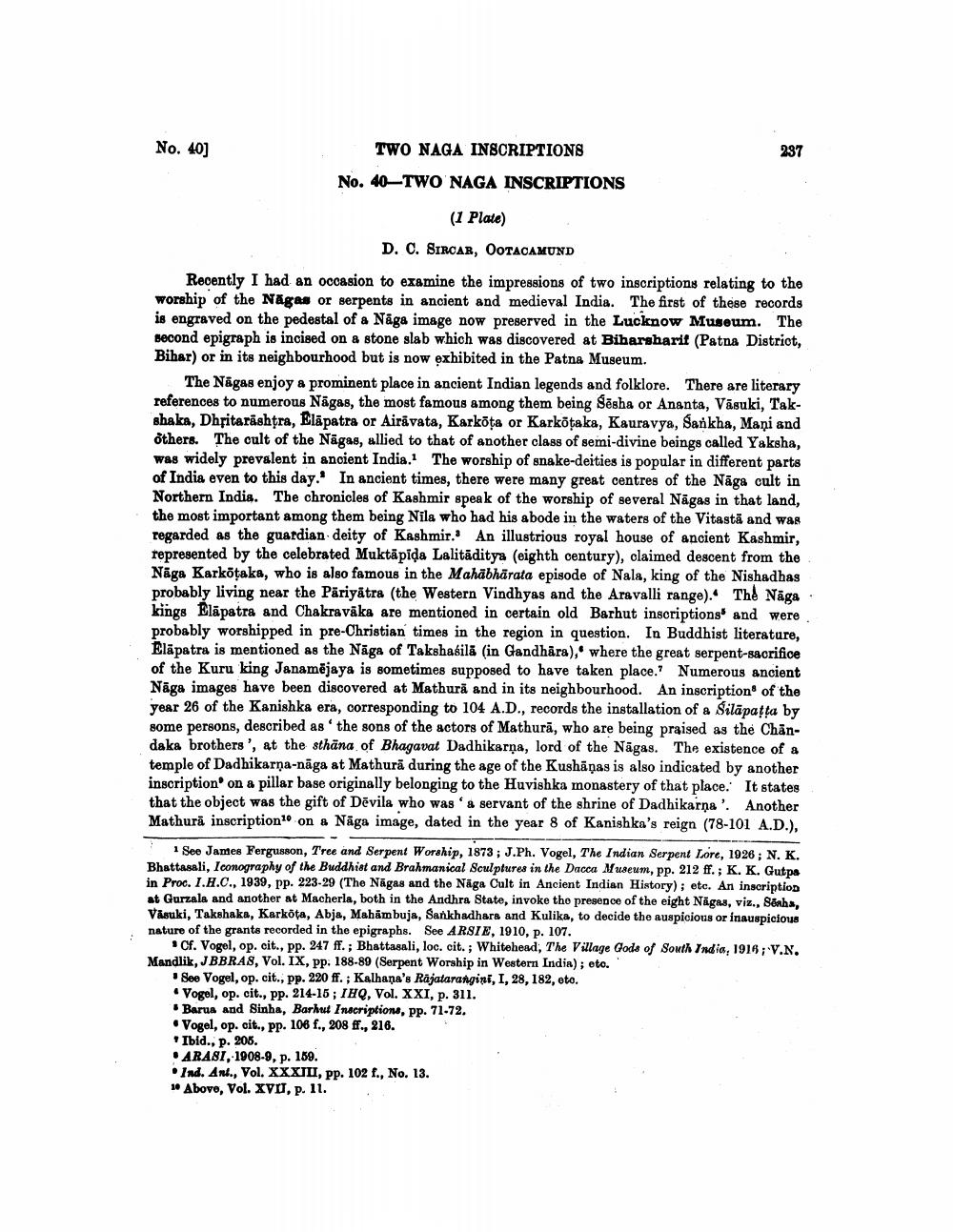________________
No. 40]
237
TWO NAGA INSCRIPTIONS No. 40-TWO NAGA INSCRIPTIONS
(1 Plate)
D. C. SIRCAR, OOTACAMUND Recently I had an occasion to examine the impressions of two inscriptions relating to the worship of the Nägas or serpents in ancient and medieval India. The first of these records is engraved on the pedestal of a Näga image now preserved in the Lucknow Museum. The second epigraph is incised on a stone slab which was discovered at Biharsharit (Patna District, Bihar) or in its neighbourhood but is now exhibited in the Patna Museum.
The Nāgas enjoy a prominent place in ancient Indian legends and folklore. There are literary references to numerous Nāgas, the most famous among them being Sēsha or Ananta, Väsuki, Takshaka, Dhritarashtra, Eläpatra or Airavata, Karköta or Karkötaka, Kauravya, Sankha, Maņi and others. The cult of the Nāgas, allied to that of another class of semi-divine beings called Yaksha, was widely prevalent in ancient India. The worship of snake-deities is popular in different parts of India even to this day.' In ancient times, there were many great centres of the Nāga cult in Northern India. The chronicles of Kashmir speak of the worship of several Nāgas in that land, the most important among them being Nila who had his abode in the waters of the Vitastā and was regarded as the guardian deity of Kashmir. An illustrious royal house of ancient Kashmir, represented by the celebrated Muktāpida Lalitāditya (eighth century), claimed descent from the Näga Karkötaka, who is also famous in the Mahābhārata episode of Nala, king of the Nishadhas probably living near the Päriyātra (the Western Vindhyas and the Aravalli range). The Näga kings Elāpatra and Chakravāka are mentioned in certain old Barhut inscriptions and were probably worshipped in pre-Christian times in the region in question. In Buddhist literature, Elāpatra is mentioned as the Näga of Takshasilă (in Gandhāra), where the great serpent-sacrifice of the Kuru king Janamējaya is sometimes supposed to have taken place.? Numerous ancient Nāga images have been discovered at Mathură and in its neighbourhood. An inscription of the year 26 of the Kanishka era, corresponding to 104 A.D., records the installation of a Silāpatta by some persons, described as the sons of the actors of Mathurā, who are being praised as the Chandaka brothers', at the sthāna of Bhagavat Dadhikarņa, lord of the Nāgas. The existence of a temple of Dadhikarna-naga at Mathura during the age of the Kushäņas is also indicated by another inscription on a pillar base originally belonging to the Huvishka monastery of that place. It states that the object was the gift of Dēvila who was & servant of the shrine of Dadhikarna'. Another Mathură inscription on a Näga image, dated in the year 8 of Kanishka's reign (78-101 A.D.),
See James Fergusson, T'ree and Serpent Worship, 1873; J.Ph. Vogel, The Indian Serpent Lore, 1926; N. K. Bhattasali, Iconography of the Buddhist and Brahmanical Sculptures in the Dacca Museum, pp. 212 ff.; K. K. Gutpa in Proc. I.2.C., 1939, pp. 223-29 (The Nägas and the Nāga Cult in Ancient Indian History); etc. An inscription at Gurzala and another at Macherla, both in the Andhra State, invoke the presence of the eight Nägas, viz., Bonha, Visuki, Takshaka, Karköta, Abja, Mahambuja, Sankhadhara and Kulika, to decide the auspicious or inauspicious nature of the grants recorded in the epigraphs. See ARSIE, 1910, p. 107.
Cf. Vogel, op. cit., pp. 247 ff.; Bhattasali, loc. cit.; Whitehead, The Village Gods of South India, 1916; V.N. Mandlik, JBBRA8, Vol. IX, pp. 188-89 (Serpent Worship in Western India); eto.
See Vogel, op. cit., pp. 220 ff.; Kalhana's Rajatarangini, I, 28, 182, oto. • Vogel, op. cit., pp. 214-15; IHQ, Vol. XXI, p. 311.
Barua and Sinha, Barhut Inscriptions, pp. 71-72. • Vogel, op. cit., pp. 106 f., 208 ff., 216. * Ibid., p. 206. ARASI, 1908-9, p. 159.
Ind. Ant., Vol. XXXIII, pp. 102 f., No. 13. *Above, Vol. XVII, p. 11.




